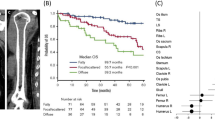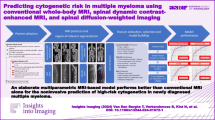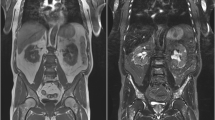Abstract
Objectives
To compare the diagnostic performance of whole-body MRI (WBMRI) with haematological parameters for detecting persistent or relapsing disease in patients with multiple myeloma after stem cell transplantation.
Methods
Sixty-six WBMRI acquisitions were performed in 33 patients with multiple myeloma at two time points after stem cell transplantation. Extent of disease and inter-test dynamics of intra- and extramedullary myeloma manifestations were compared (kappa statistics) with Uniform Response Criteria, comprising haematological parameters.
Results
Using data from 66 sequential WBMRI acquisitions in 33 patients, 10 patients (30.3 %) were classified as having progressive disease and 23 (69.7 %) as being in remission. Eight (80 %) of the ten patients with progressive disease revealed intramedullary lesions, and two patients (20 %) had intra- and extramedullary lesions. WBMRI and laboratory tests were concordant in 26/33 (78.8 %) patients. We found an agreement of 51.2 %, 95 % confidence interval 19.8 %-82.6 %, between results from WBMRI and haematological parameters. WBMRI had a sensitivity of 63.6 %, specificity of 86.4 %, PPV of 70.0 %, NPV of 82.6 % and accuracy of 78.8 % for detection of remission.
Conclusions
WBMRI allows the detection and exact localisation of intra- and extramedullary myeloma manifestations after stem cell transplantation, but shows only moderate agreement with routinely performed laboratory tests for determination of remission.
Key Points
• Whole body magnetic resonance imaging (WBMRI) is increasingly used for oncological purposes
• WBMRI allows localisation of intra- and extramedullary myeloma manifestations after SCT
• However, WBMRI and serum analyses do not fully concur when assessing response
• Thus, WBMRI offers limited incremental value over laboratory tests to determine remission



Similar content being viewed by others
Abbreviations
- WBMRI:
-
whole-body magnetic resonance imaging
- MRI:
-
magnetic resonance imaging
- SCT:
-
stem cell transplantation
- MM:
-
multiple myeloma
- CR:
-
complete remission
- PD:
-
progressive disease
- PR:
-
partial remission
- SD:
-
stable disease
References
Bataille R, Harousseau JL (1997) Multiple myeloma. N Engl J Med 336:1657–1664
Palumbo A, Anderson K (2011) Multiple myeloma. N Engl J Med 364:1046–1060
Sirohi B, Powles R (2004) Multiple myeloma. Lancet 363:875–887
Parkin DM, Bray F, Ferlay J, Pisani P (2005) Global cancer statistics, 2002. CA Cancer J Clin 55:74–108
Bensinger WI (2009) Role of autologous and allogeneic stem cell transplantation in myeloma. Leukemia 23:442–448
Lokhorst H, Einsele H, Vesole D et al. International Myeloma Working Group consensus statement regarding the current status of allogeneic stem-cell transplantation for multiple myeloma. J Clin Oncol 28:4521–4530
Kroger N (2007) Mini-Midi-Maxi? How to harness the graft-versus-myeloma effect and target molecular remission after allogeneic stem cell transplantation. Leukemia 21:1851–1858
Attal M, Harousseau JL, Facon T et al (2003) Single versus double autologous stem-cell transplantation for multiple myeloma. N Engl J Med 349:2495–2502
Barlogie B, Tricot GJ, van Rhee F et al (2006) Long-term outcome results of the first tandem autotransplant trial for multiple myeloma. Br J Haematol 135:158–164
Harousseau JL, Dreyling M (2009) Multiple myeloma: ESMO clinical recommendations for diagnosis, treatment and follow-up. Ann Oncol 20:97–99
Kroger N, Bacher U, Bader P et al. NCI First International Workshop on the Biology, Prevention, and Treatment of Relapse after Allogeneic Hematopoietic Stem Cell Transplantation: report from the Committee on Disease-Specific Methods and Strategies for Monitoring Relapse following Allogeneic Stem Cell Transplantation. Part I: Methods, acute leukemias, and myelodysplastic syndromes. Biol Blood Marrow Transplant 16:1187–1211
Rajkumar SV, Harousseau JL, Durie B et al. Consensus recommendations for the uniform reporting of clinical trials: report of the International Myeloma Workshop Consensus Panel 1. Blood 117:4691–4695
Durie BG, Harousseau JL, Miguel JS et al (2006) International uniform response criteria for multiple myeloma. Leukemia 20:1467–1473
Dimopoulos M, Terpos E, Comenzo RL et al (2009) International myeloma working group consensus statement and guidelines regarding the current role of imaging techniques in the diagnosis and monitoring of multiple Myeloma. Leukemia 23:1545–1556
D'Sa S, Abildgaard N, Tighe J, Shaw P, Hall-Craggs M (2007) Guidelines for the use of imaging in the management of myeloma. Br J Haematol 137:49–63
Derlin T, Weber C, Habermann CR et al (18)F-FDG PET/CT for detection and localization of residual or recurrent disease in patients with multiple myeloma after stem cell transplantation. Eur J Nucl Med Mol Imaging. doi: 10.1007/s00259-011-1993-8
Fonti R, Salvatore B, Quarantelli M et al (2008) 18 F-FDG PET/CT, 99mTc-MIBI, and MRI in evaluation of patients with multiple myeloma. J Nucl Med 49:195–200
Shortt CP, Carty F, Murray JG. The role of whole-body imaging in the diagnosis, staging, and follow-up of multiple myeloma. Semin Musculoskelet Radiol 14:37–46
Durie BG (2006) The role of anatomic and functional staging in myeloma: description of Durie/Salmon plus staging system. Eur J Cancer 42:1539–1543
Lecouvet FE, Dechambre S, Malghem J, Ferrant A, Vande Berg BC, Maldague B (2001) Bone marrow transplantation in patients with multiple myeloma: prognostic significance of MR imaging. AJR Am J Roentgenol 176:91–96
Lin C, Luciani A, Belhadj K et al. Multiple myeloma treatment response assessment with whole-body dynamic contrast-enhanced MR imaging. Radiology 254:521–531
Blade J, Samson D, Reece D et al (1998) Criteria for evaluating disease response and progression in patients with multiple myeloma treated by high-dose therapy and haemopoietic stem cell transplantation. Myeloma Subcommittee of the EBMT. European Group for Blood and Marrow Transplant. Br J Haematol 102:1115–1123
Kramer MS, Feinstein AR (1981) Clinical biostatistics. LIV. The biostatistics of concordance. Clin Pharmacol Ther 29:111–123
Bauerle T, Hillengass J, Fechtner K et al (2009) Multiple myeloma and monoclonal gammopathy of undetermined significance: importance of whole-body versus spinal MR imaging. Radiology 252:477–485
Horger M, Weisel K, Horger W, Mroue A, Fenchel M, Lichy M. Whole-body diffusion-weighted MRI with apparent diffusion coefficient mapping for early response monitoring in multiple myeloma: preliminary results. AJR Am J Roentgenol 196:W790-795
Author information
Authors and Affiliations
Corresponding author
Rights and permissions
About this article
Cite this article
Bannas, P., Hentschel, H.B., Bley, T.A. et al. Diagnostic performance of whole-body MRI for the detection of persistent or relapsing disease in multiple myeloma after stem cell transplantation. Eur Radiol 22, 2007–2012 (2012). https://doi.org/10.1007/s00330-012-2445-y
Received:
Revised:
Accepted:
Published:
Issue Date:
DOI: https://doi.org/10.1007/s00330-012-2445-y




